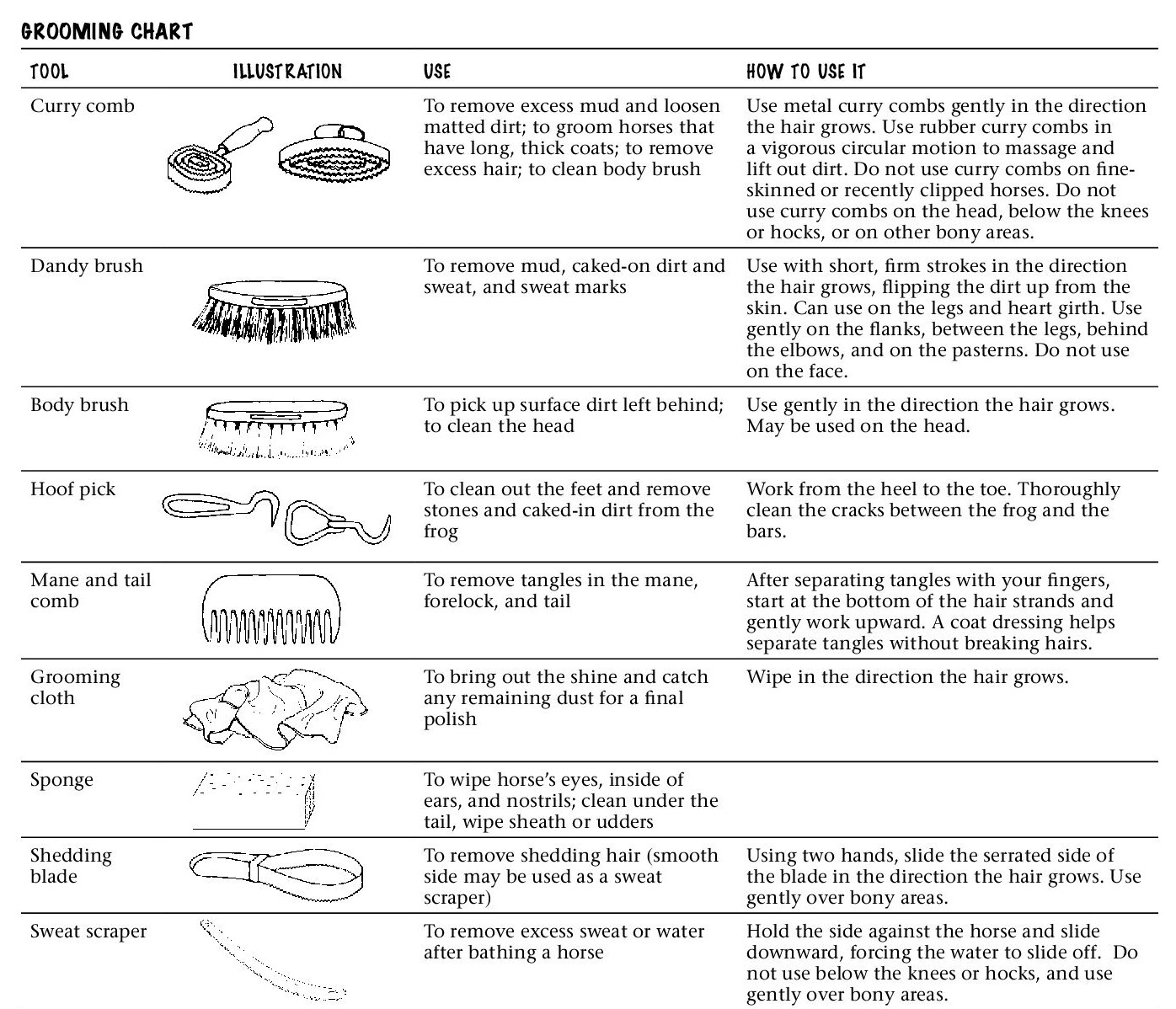Grooming
Grooming is an important part of a horse’s health care. Daily grooming cleans the hair, stimulates natural oils which make the coat shine, and lessens the possibility of skin diseases and parasites. Vigorous massaging improves the condition of muscles. Injuries can be found and treated promptly.
Follow these safety guidelines at all times when working around horses:
• Speak to the horse before touching it to avoid startling it or getting kicked.
• Never stand directly behind a horse to groom. To brush the tail, stand near the point of the buttock, to the side and facing the rear. Hold the tail and bring it around to you.
• Pick up all grooming equipment and do not leave anything in the stall.
• When tying a horse, always use a h and quick-release knot (or panic snaps on cross ties). Tie to something that is safe, secure, and solid (never to fence board, wire fences, gates, wobbly or rotten posts, cars, machinery, etc.).
• Stay behind the forelegs (because a horse may strike) and in front of the hind
legs (so you have less chance of getting kicked).
• Walk close around the hindquarters, keeping your hand on the horse and talking so it knows you are there.
• Have at least a 90-degree angle between the horse and the tie point so that you won’t get pinned if the horse suddenly moves over.
• Never walk under a horse’s head or neck when it is tied. The horse may pull back and lunge forward, pinning you against the tie rail, fence, or wall.
• Never crawl under a horse.
Grooming Procedure
Use grooming tools in the following order:
1. Curry comb
2. Dandy brush
3. Body brush
4. Mane and tail comb
5. Hoof pick
6. Cloth

Begin grooming at the horse’s left (near) shoulder. Depending on how dirty the horse is, you may start with the curry or the dandy brush. First clean the neck, then the back, girth, barrel, and finally the hindquarters and legs. It is very important to clean the back and girth area so the horse won’t get sores from the saddle and the girth.
Repeat the process on the right (off) side.
When the horse is mostly clean, brush its entire body with the body brush. Then brush or comb the mane and tail.
Next, use a hoof pick to clean out dirt and debris from each hoof. Always work from heel to toe. Begin by running the pick down the grooves on each side of the frog. Then run the pick around the inside rim of the shoe to clean off the sole. Gently clean the cleft in the center of the frog. It’s a good idea to use a brush to clean off the sole thoroughly. Not only does this remove any remaining bits of dirt,
but it allows you to inspect the foot for signs of bruising, thrush, cracks, punctures, or abscesses. When you are done cleaning a hoof, be sure you set the foot back down. Do not just it.
Here is a safe and easy way to pick up a horse’s foot. Approach the horse’s shoulder diagonally, and talk to make sure your horse knows you are there. To pick up a front foot, stand beside the shoulder, face the rear, and place your nearer hand on the horse’s shoulder. Run the other hand gently but firmly down the front of the leg and grasp the fetlock. Squeeze in with your thumb and forefinger while lightly pushing on the horse’s shoulder to force its weight onto the opposite leg. Pick up the foot and support it on your knee.
To pick up a rear foot, face toward the rear with the inside hand on the point of the hip. Run the other hand down the back of the leg and grasp the cannon just above the fetlock.
Push the horse’s weight onto its opposite leg and squeeze with your hand. Pick up the foot, lifting it forward. Then step to the rear, bringing the hoof straight back. Avoid pulling the leg out to the side.
Finish grooming by running over the horse’s entire body with a soft cloth.
Wash grooming equipment with soap and warm water often enough to keep it clean.
To avoid spreading skin diseases, don’t lend or borrow tools. If you have to share tools, disinfect them before using them on another horse.
To remove excess mud and loosen matted dirt; to groom horses that have long, thick coats; to remove excess hair; to clean body brush Use metal curry combs gently in the direction the hair grows. Use rubber curry combs in a vigorous circular motion to massage and lift out dirt. Do not use curry combs on fine- skinned or recently clipped horses. Do not use curry combs on the head, below the knees or hocks, or on other bony areas.
Dandy brush: To remove mud, caked-on dirt and sweat, and sweat marks Use with short, firm strokes in the direction the hair grows, flipping the dirt up from the skin. Can use on the legs and heart girth. Use gently on the flanks, between the legs, behind the elbows, and on the pasterns. Do not use on the face.
Body brush: To pick up surface dirt left behind; to clean the head Use gently in the direction the hair grows. May be used on the head.
Hoof pick: To clean out the feet and remove stones and caked-in dirt from the frog Work from the heel to the toe. Thoroughly clean the cracks between the frog and the bars.
Mane and tail comb: To remove tangles in the mane, forelock, and tail. After separating tangles with your fingers, start at the bottom of the hair strands and gently work upward. A coat dressing helps separate tangles without breaking hairs.
Grooming cloth: To bring out the shine and catch any remaining dust for a final polish Wipe in the direction the hair grows.
Sponge: To wipe horse’s eyes, inside of ears, and nostrils; clean under the tail, wipe sheath or udders
Shedding blade: To remove shedding hair (smooth side may be used as a sweat scraper). Using two hands, slide the serrated side of the blade in the direction the hair grows. Use gently over bony areas.
Sweat scraper: To remove excess sweat or water after bathing a horse Hold the side against the horse and slide downward, forcing the water to slide off. Do not use below the knees or hocks, and use gently over bony areas.
Bathing
Washing a horse—either with or without soap—removes dirt, stains, and sweat that cannot be removed by grooming. Don’t shampoo too often, because you might remove protective hair and skin oils. Use a livestock shampoo or mild nondetergent soap to avoid removing the horse’s natural oil.
Wet the horse thoroughly all over with a hose or sponge. Use a sponge on the head;
pinch the ears shut (if necessary) to keep water out. You may apply shampoo directly to the coat or mix it in a bucket. Scrub the horse with a sponge or a soft brush. Rinse thoroughly.
Wet and shampoo one section at a time if the horse is drying too fast.
Carefully wash out a gelding’s sheath with a hose to remove dirt and shavings that can cause urinary problems. Sponge a mare’s udder with soap and water. Soap irritates the tender skin; use a mild soap, and be sure to rinse well.
Wipe off excess water with a sweat scraper or the smooth side of a shedding blade, using long sweeping strokes. Do not scrape the head or legs. Some coat dressings are sprayed on a wet coat, while others are for use after the horse is dry. Avoid oily dressings; they attract dust. Dry the horse with towels or a cool air dryer. Walk the horse in the shade until it is completely dry (the sun “burns” or curls wet hair). Use a light stable sheet to keep the horse from getting chilled in cool weather, and do not bathe a horse in cold weather.

.jpg)






